IJCRR - 13(22), November, 2021
Pages: 121-128
Date of Publication: 20-Nov-2021
Print Article
Download XML Download PDF
Nutritional and Nutraceutical Properties of Upland Edible Aroids and Selection of Superior Germplasm from Borail Hills Range, India
Author: Medhi Pramod, Choudhury Shally Sultana, Sarma Aniruddha, Sarma Pranab Pratim, Harish GD
Category: Healthcare
Abstract:Introduction: Borail Hills Range of Assam State of India has an enormous variety of tuber crops including aroids are important for the ethnic people for their regular dietary supplements. During scarcity of major cereal rice, the tubers play a major role in the regular diet of the ethnic groups like Dimasas, Zeme Nagas, Hmars, Hrangkhols, Biates, Kukis, Sakacheps, Vaipheis and Pnars. Aim: Quantification of the nutritional (viz. Carbohydrate, Protein, Total Fat, Crude fibre and Calorific value); nutraceutical (viz. Total mineral content, phenol content, antioxidant activity, flavonoid and the ascorbic acid); anti-nutritional (oxalates/ammonium oxalates) properties and also microelement (viz. Ca, Fe and Zn) of upland edible aroids. Methodology: Collection of the edible aroid tubers from the study area was followed by preparation of passport data and obtained Indigenous Collection numbers from Indian Council of Agricultural Research-National Bureau of Plant Genetic Resource (ICAR-NBPGR), New Delhi. Tuber samples were dried and ground to moisture-free powder for phytochemical analysis for nutritional, anti-nutritional, neutraceutical and micronutrient quantification were done. Result: A total of 27 numbers of cultivar and wild edible aroids belongs to 11 species and variability within them was analyzed phytochemically. Phytochemical analyses were broadly categorized and tabulated into nutritional property estimation, nutraceutical and anti-nutritional property estimation and microelement quantification. Conclusion: After phytochemical analysis, five nutritionally and nutraceutical superior Colocasia esculenta variants were selected (IC-0631527, 0631529, 0631536, 0631544 and 0631546) emphasizing higher calorific value and also lower anti-nutritional properties. All the selected superior germplasm were multiplied for field trial leading to agro technique development for upland cultivation.
Keywords: Aroids, Nutritional, Anti-nutritional, Nutraceutical analysis, Superior germplasm, Borail Hills Range, India
Full Text:
Introduction
Edible aroids consist of Colocasia (taro, eddoe, dasheen), Xanthosoma (tannia, new cocoyam), Alocasia (giant taro) and Amorphophallus (elephant foot yam). In addition to the tubers, the leaves and leaf petiole are used as vegetables. Colocasia and Xanthosoma occupy an important role in the diet of many tropical countries.1
The nutritional composition of roots and tubers varies from place to place depending on the agro-climate, the crop variety and other factors.2 Again, the dietary habits of the population in different regions of the world have been determined mainly by the availability of foods locally and also local practices.3 Also, taro tubers play an important role in the livelihood of millions of relatively poor people in less developed countries and are an excellent source of carbohydrates.4 Moreover, edible aroid corms and leaves are traditionally used to cure many ailments.5
A perusal of literature reveals that tender Taro leaves eaten cooked as vegetables contain higher protein and also a good source of carotene; minerals like potassium, calcium, phosphorous, iron and vitamins like riboflavin, thiamine, niacin, vitamin A, vitamin-C and also dietary fibre.6,7 Nutritionally, taro corms contain 63-85% water, 1.3-3.0% protein, 0.2-0.4% fat, 6.0% carbohydrates and appreciable quantities of Vitamins-C (15.34-61.72 mg/100 g). There was considerable variability in the mineral composition of taro and they appeared to be good sources of potassium, calcium, iron, copper and manganese.8
Production of certain free radicals in the human body may be enhancing the chances of diseases like cancer, rheumatoid arthritis, and atherosclerosis as well as ageing-related problems.3
Organisms are well protected against free radical damage by the enzymes like superoxide dismutase and catalase. Compounds like ascorbic acid, and tocopherols can prevent oxidative stress.9 However the natural antioxidant such as vitamin C, E, carotenoids, phenolic compounds, etc. that are present in herbs and spices are responsible for inhibiting the deleterious consequences of oxidative stress exerted by the reactive oxygen species (ROS).10 It has also been reported that the antioxidant activity of plant materials are well correlated with the content of their phenolic compounds.11,12
Many works have been done on different aspects of aroids worldwide. But, research work on the chemical and nutritional content of North East Indian wild edible tubers, rhizomes, corms, roots and stems is scanty and sporadic.13,14
Borail Hills Range of Assam State of North East India coordinates in between 24º 58/ N to 25° 50/ N latitudes and 92° 50/ E to 92° 52/ E longitudes. The ethnic groups of the area are- Dimasas, Zeme Nagas, Hmars, Hrangkhols, Biates, Kukis, Sakacheps, Vaipheis and Pnars. Aroids have a good sign for them from nutritional aspects. During the late winter months (i.e. by late January), when Jhum rice stock begins to exhaust, they mix rice with the tubers for an additional nutritional supplement. Again, additional income generation by selling their agro-products in the nearby makeshift markets is also another output for the economic wellbeing of those ethnic groups.15a,15b The present work was undertaken to estimate the nutritional, anti-nutritional and nutraceutical properties of upland edible aroids for the selection of nutritionally superior germplasms from Borail Hills Range of Assam State of North East India.
2. Materials and methods
2.1. Collection and sample preparation
Individual sampling was done selectively for collecting the aroid germplasm samples during September 2016 and February 2017. Passport information data on each accession was recorded at the time of collection, following the standard procedure of the Indian Council of Agricultural Research-National Bureau of Plant Genetic Resource (ICAR-NBPGR).16 Subsequently, all the collected aroid germplasms were submitted to ICAR-NBPGR Regional Station, Shillong, India for further conservation and multiplication and later Indigenous Collection (IC) numbers of each of the accessions were obtained from National Authority (NBPGR).
Collected upland edible aroid corms or cormels were cleaned, sliced and air-dried properly. Then the samples were dried in a hot air oven at 60°C till a constant weight was obtained. Then the dried materials were ground to powder form and stored at 4° C for further analysis.
2.2. Methods of analysis
All the phytochemical analyses were done on a moisture-free basis. Laboratory analysis of upland edible aroid samples was carried out to estimate the nutritional (viz. Carbohydrate, Protein, Total Fat, Total Crude fibre contents and Calorific value), nutraceutical (viz. Total mineral content, total phenolic content, antioxidant activity, ascorbic acid and the flavonoid content), antinutritional properties (viz. oxalates/ammonium oxalates) and also quantification of microelement (viz. Ca, Fe and Zn).
2.2.1. Nutritional analysis
Total carbohydrate estimation was done by following the standard procedure of the Anthrone method.17Total protein estimation was done by following Lowry’s method.18Total fat content determination was done by using the Soxhlet apparatus. The crude fibre in the samples was determined and extracted fibre was expressed as a percentage of the original defatted sample and calculated.19 Calorific values were estimated by using a Bomb colourimeter (Optics Tech Make).
2.2.2. Nutraceutical analysis
The amounts of ascorbic acid present in the samples were calculated by using 2, 6- dichloro phenol indophenol dye.20For quantitative estimation of flavanoid, spectroscopic analysis was done21 for the present study. The total phenol content was determined by Folin-Ciocalteau’s method.22The antioxidant activities of the sample extracts along with standard were assessed based on the radical scavenging effect of the stable DPPH method.23
2.2.3. Anti-nutritional analysis
The standard permissible limit of the oxalate contents in edible aroids is 71mg/100g and beyond this limit is not recommended for human consumption. Estimation of anti-nutritional properties (oxalates/ ammonium oxalates) was done by titration method.24
2.2.4. Micronutrients analysis
Quantification of microelement viz. Ca, Fe and Zn were done by Atomic Absorption Spectrophotometer (AAS) [Model: AAS-700, Perkin Elmer]. Standard methodology as advocated by Jackson 25 and Brooks26 was utilized for the digestion and analytical procedures for quantification of total metal concentration in dried sample powders.
2.2.5. Statistical Analysis
The data generated were subjected to statistical analysis. All the assays except the micronutrients were recorded in triplicates and the average values were expressed as Standard Deviation (mean ±SD).
3. Results
A total of 27 numbers of cultivar and wild edible aroids belongs to 11 species and variability within them from the agro-climatic zone of the Borail Hills Range of Assam State of North East India were analyzed phytochemically. The present phytochemical studies on the edible upland aroids have been broadly subdivided into the following and the findings are presented in Table-1, 2 and 3 respectively -
-
Nutritional property estimation (viz. Carbohydrate, Protein, Total Fat, Total Crude fibre contents and Calorific value) (Table-1).
-
Nutraceutical and Anti-nutritional property estimation (viz. Total mineral content, total phenolic content, antioxidant activity, flavonoid and the ascorbic acid content) (Table-2).
-
Microelement quantification (viz. Ca, Fe and Zn) (Table-3).
4. Discussion
Phyto-chemical content variability of the aroid tubers is related to species origin, geography, planting season, the season of harvest and agronomic factors like the soil quality.6 Thus, the nutritional composition of roots and tubers varies from place to place depending on the climate, the soil, the crop variety and other factors.27
From the present study total percentage (%) of carbohydrate, total protein, total fat and crude fibre were recorded to be ranging from 22.56±0.24 (IC-0631541) to 64.93±0.01 (IC-0631536), 2.30±0.05 (IC-0631530) to 4.65±0.01 (IC-0631538), 0.48±0.01(IC-0631523) to 4.78± 0.04 (IC-0631531) and 1.35 ±0.32 (IC-0631528) to 29.95±0.23 (IC-0631523) respectively. Calorific values was ranging from 237.14±04 (IC-0631541) to 365.10±0.21(IC-0631527) kcal/100g.
The antioxidant in food items reduces oxidative damage to the consumer as many plant products have been validated as the source of natural antioxidants. Enzymes like Superoxide dismutase and catalase or compounds such as ascorbic acid, phenolic compounds, tocopherols, β-carotene, lycopene and glutathione, etc.28 act as an antioxidant agent. Total phenolics and other natural products like vitamin C and carotenoids have been shown to possess various biological properties related to antioxidant activity.29, 30, 31 Present work revealed the ranges of antioxidant activity (IC50= µg/ml) from 183.01±0.05 (IC-0631549) to 96.94±0.05 (IC- 0631523).
Again, the value ranges of ascorbic acid (mg/100g), flavonoid (µGqe/mg), total phenol content (µgGAE/mg), total minerals content (%) were recorded from 10.81 ±0.23 (IC-0631528) to 38.56±0.04 (IC-0631546), 3.45±0.32 (IC-0631523) to 9.21±0.12 (IC-0631522), 14.02±0.26 (IC-0631533) to 34.20±0.02 (IC-0631523) and 1.02±0.37 (IC-0631525) to 15.3± 0.15 (IC-0631547) respectively.
Anti-nutritional properties (mg/100g) range was from 55.15±0.44 (IC-0631550) to 104.02±0.59 (IC-0631539).
The main nutrient supplied by taro tubers is dietary energy provided by carbohydrates. However, low protein and fat contents in taro tuber limit in preparation of protein and fat-rich foods. The outcome of the present work on the nutritional, nutraceutical and anti-nutritional property studies of the edible upland aroids may be significant for nutritional applications and diet formulations.
5. Conclusion:
Out of 27 numbers of cultivar and wild edible aroids analyzed phytochemically, a total of 5 Colocasia esculenta variants, which are nutritionally and nutraceuticals superior (i.e. IC-0631527, 0631529, 0631536, 0631544 and 0631546) were selected emphasizing mainly the calorific value and also lower anti-nutritional properties of the tubers or cormels studied. All the selected superior taro germplasm were multiplied for field trial leading to agro technique development for upland cultivation.
Thus, the development of upland taro agro-technique or package of practice for enhanced tuber crop productivity has been taken up as follow up action. Thus, enhanced productivity will be helpful to set up new agro-based (i.e. aroid) cottage industries. So, as a future scope, germplasm conservation and multiplication for the future breeding programme, also production and marketing of the commercial starch from tubers which are used in adhesives, dextrins, food, sweeteners, ethyl alcohol production, soaps and detergents, laundry, cosmetic, pharmaceuticals and biodegradable plastics, etc. will be helpful for the opening of new vistas for agro-based cottage industries for the economic wellbeing of the ethnic people of North East India.
5. Acknowledgements
The authors express their heartfelt thanks to the ethnic people of Borail Hills Range of India for sharing their knowledge on edible aroids. The authors are also thankful to the Natural Resource Data Management System, Department of Science and Technology, Government of India for awarding the research project. The authors are also thankful to the Indian Council of Agricultural Research-National Bureau of Plant Genetic Resource(ICAR-NBPGR), New Delhi for providing Indigenous Collection (IC) numbers of the collected aroid samples.
Conflict of interest: The author(s) declare(s) that they have no competing interests.
Source Funding: Natural Resource Data Management System, Department of Science and Technology, Government of India, New Delhi for funding (April 2016 to December 2018) in the form of the research project.
Authors’ contributions
Pramod Medhi carried out the taro germplasm collection, taxonomic identification, sample preparation and phytochemical analysis works. Shally Sultana Choudhury, Aniruddha Sarma and Pranab Pratim Sarma also carried out phytochemical analysis works. Harish GD assisted in getting Indigenous Collection (IC) numbers from the national authority.
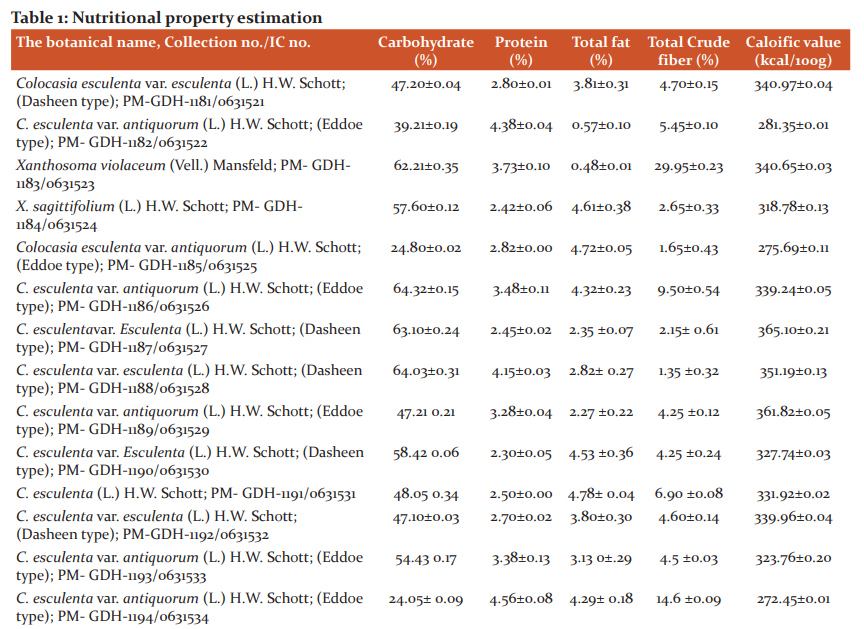
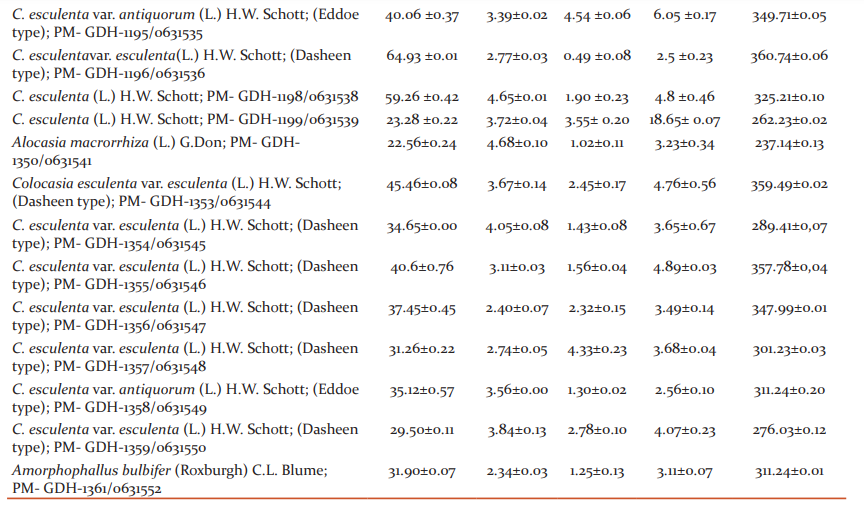
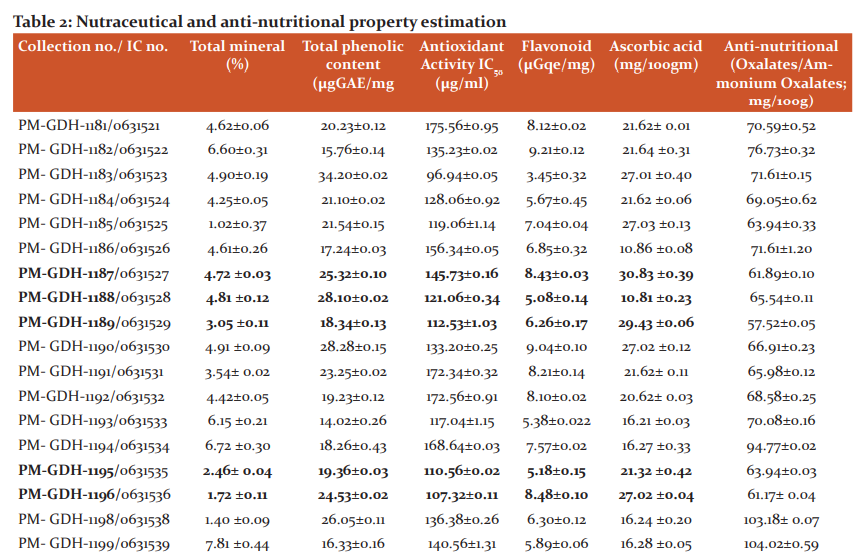
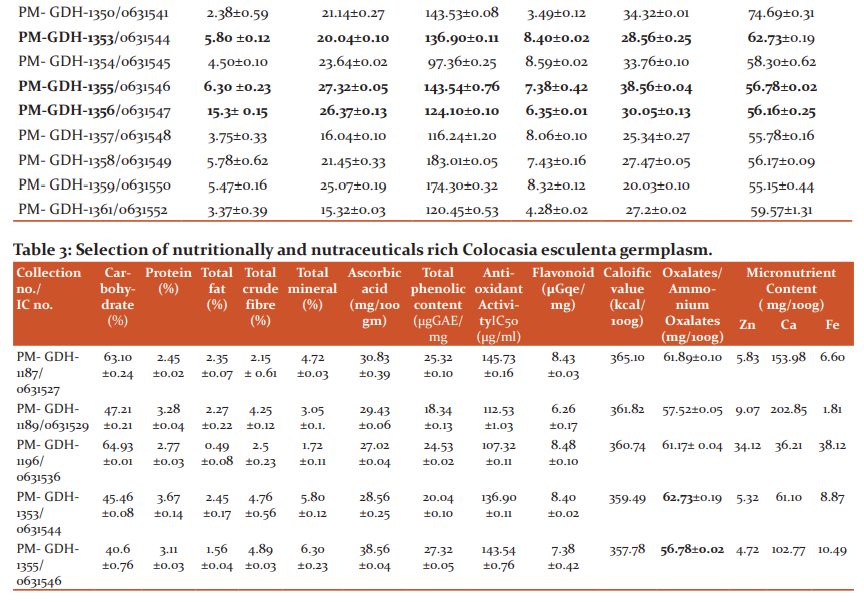
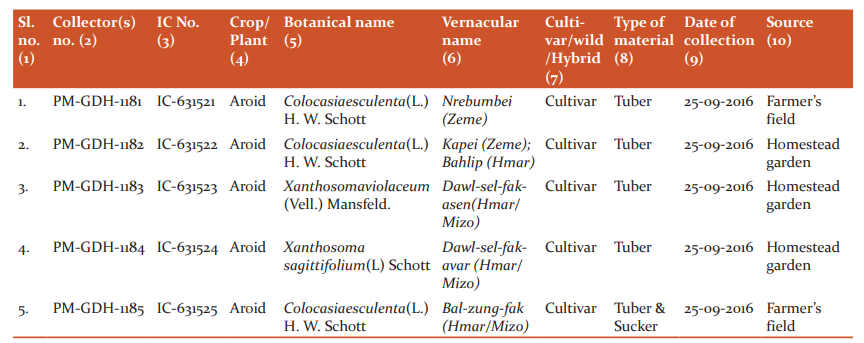


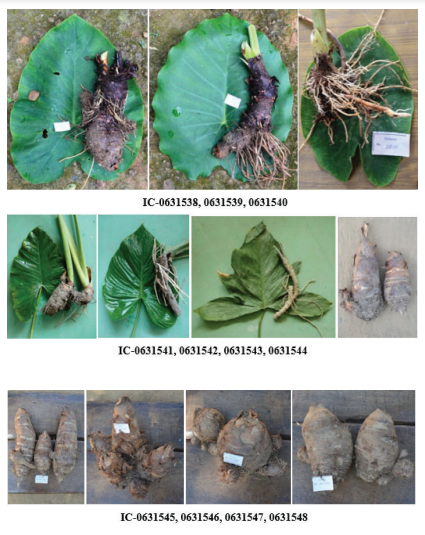

References:
-
Peter VK. Tuber Crops. National Book Trust, New Delhi, India. 2008; pp. 1-250.
-
FAO. Production Year Book for 1997. Food and Agriculture Organization of the United Nations, Rome, Italy. 1998.
-
Halliwell B, GutteridgeJMC. Free Radicals in Biology and Medicine. 3rd Edn, Oxford University Press, Oxford, New York. 1999; pp.105-245.
-
Oke OL. Roots, tubers, plantains and bananas in human nutrition. Rome: FAO Corporate Documentary Repository, FAO, United Nations. 1990.
-
Tuse TA, Harle UN, Bore VV. The hepato-protective activity of Colocasia antiquorum against experimentally induced liver in Rats. Malyas. J. Pharm. Sci. 2009; 17(2): 99-112.
-
Bradbury JH, Holloway WD. Chemistry of tropical root crops: significance for nutrition and agriculture in the Pacific. Australian Cent Int Agricultural Res. Canberra, Australia. 1988.
-
Opara LU. Edible aroids: post-harvest operations. AGST/FAO. 2001.
-
Onwueme IC. Taro cultivation in Asia and Pacific (FAO-RAP Publication No. 1999/16). 1999.
-
Mau JL, Chang CN, Huang SJ, Chen CC. Antioxidant properties of methanolic extracts from Grifolafrondosa, Morchellaesculanta and Termitomycesalbuminosus mycelia. Food Chem. 2004; 87: 111–118.
-
Mondal SK, Chakraborty G, Gupta M, Mazumdar UK. Hepatoprotective activity of Diospyrosmalabarica bark in carbon tetrachloride intoxicated rats. European Bull Drug Res. 2005; pp. 13-25.
-
Cakir A, Ahmet Yildirim MA, Duru ME, Harmandar M, Kazaz C. Isolation and Characterization of antioxidant Phenolic Compounds from the Aerial Parts of Hypericum hyssopifolium L. by activity-guided fractionation, J Ethnopharm. 2003; 87: 73-83.
-
Velioglu YS, Mazza G, Gao L, Oomah B D. Antioxidant activity and total phenolics in selected fruits, vegetables, and grain products. J. Agric. Food Chem. 1998; 46(10):4113-4117.
-
Shanthakumari S, Mohan VR, John de B. Nutritional evaluation and elimination of toxic principles in wild yam (Dioscorea spp.). Trop.Subtrop. Agro-ecosystems.2008; 8: 313 -319.
-
Udensi EA, Oselebe HO, Iweala OO (). The investigation of chemical composition and functional properties of water yam (Dioscorea alata): Effect of varietals differences. Pak. J. Nutr. 2008; 7: 342 – 344.
-
a. Medhi P, Borthakur SK. Genetic Resources of Root and Tuber Crops from North Cachar Hills of Assam. J Root Crops. 2011; 37 (2):131-143.
-
Medhi P, Borthakur SK. Photo resources from North Cachar Hills of Assam-III: Edible plants sold at Haflong market. Ind. J. Nat. Prod. Resour. 2012; 3(1):84-109.
-
Mahajan RK, Sapra RL, Srivastava U, Sing M, Sarma GD. Minimal descriptors(for characterization and evaluation) of agri-horticultural crops(part-I). Nat. Bur. Plant Gen. Resour., New Delhi, India. 2000.
-
Hedge JE, BT Hofreiter. Carbohydrate Chemistry. 17th Edn, Academic Press, New York. 1962.
-
Lowry OH, Rosebrough NJ, Farr AL, Randall RJ. Protein measurement with the folin phenol reagent. J. Biol. Chem. 1951;193: 265-75.
-
Maynard AJ. Methods in Food Analysis: Physical, Chem Instrumental Methods of Analysis.2d Edition, Academic Press, San Francisco, London.1970; p. 845.
-
Sadasivam S, Theymoli B. Practical Manual in Biochemistry. Tamil Nadu Agricultural University, Coimbatore, India. 1987;14.
-
Kumar S., Antioxidant and free radical scavenging potential of Citrullus colocynthis (L.) Schrad. methanolic fruit extract; Acta Pharm. 2008; 58(2): 215-200.
-
Singleton VL, Rossi JAJ. Colourimetry of total phenolics with phosphomolybdic phosphotungstic acid reagents. Am. J. Enol. Viticulture. 1965; 16: 144-158.
-
Khalaf NA, Shakya AK, Al-Othman A, El-Agbar Z, Farah H. Antioxidant activity of some common plants. Turk. J. Biol. 2008; 32: 51-55.
-
Latta M, Eskin M. A simple and rapid colourimetric method for phytate determination. J. Agric. Food Chem. 1980; 28(6):1313-1315. https://doi.org/10.1021/jf60232a049
-
Jackson ML. Soil chemical analysis. Prentice-Hall, Englewood Cliffs, N.J. 1958; p.498.
-
Brooks RR. Biological methods of prospecting for minerals- John Wiley & Sons, New York. 1986; p. 313.
-
FAO. Production Year Book for 1997. Food and Agriculture Organization of the United Nations, Rome, Italy. 1998.
-
Halliwell, B, Gutteridge JMC. Free Radicals in Biology and Medicine. 3rd Edn, Oxford University Press, Oxford, New York. 1999; pp.105-245.
-
Prior RL., Antioxidant capacity as influenced by total phenolic and anthocyanin content, maturity, and variety of Vaccinium species. J. Agric. Food Chem. 1998; 46:2686-2693.
-
Wang H, Cao G, Prior R. L. Total antioxidant capacity of fruits. J. Agric. Food Chem. 1996; 44: 701-705.
-
Luximon-Ramma A, Bahorun T, Crozier A. Antioxidant actions and phenolic and vitamin C contents of common Mauritian exotic fruits. J. Sci. Food Agri. 2003; 83: 496-502.
|






 This work is licensed under a Creative Commons Attribution-NonCommercial 4.0 International License
This work is licensed under a Creative Commons Attribution-NonCommercial 4.0 International License